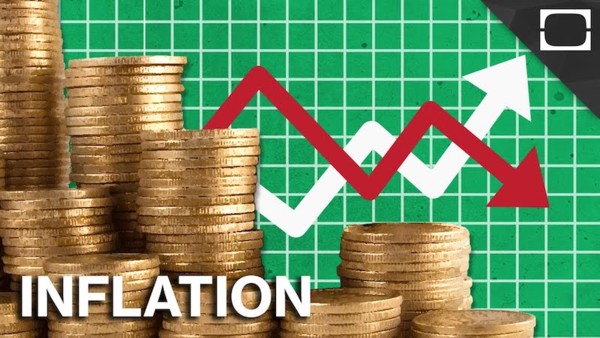In recent times, the United States has experienced a significant spike in inflation, with prices soaring at a rate not seen in over four decades. This surge has left economists, policymakers, and everyday citizens grappling with its implications. In this comprehensive article rajkotupdates.news: Us inflation jumped 7.5 in in 40 years, we will delve into the factors contributing to this phenomenon, its historical context, and the potential consequences for individuals and the broader economy. Let’s embark on a journey to unravel the mysteries of the 7.5% inflation jump in 40 years.
The Basics of Inflation
To grasp the current situation, it’s crucial to start with the fundamentals. Inflation is the rate at which the general level of prices for goods and services rises, eroding purchasing power. It’s typically measured as an annual percentage increase. But what exactly is causing this sharp uptick in prices?
COVID-19 Pandemic’s Legacy
The COVID-19 pandemic has had far-reaching consequences, and its impact on inflation cannot be understated. Lockdowns, supply chain disruptions, and increased demand for certain goods have all played a part in driving prices higher. Let’s examine these factors in detail.
-
Supply Chain Disruptions
One of the primary contributors to inflation has been disruptions in the global supply chain. When factories shut down, transportation slowed, and borders closed, the flow of goods and raw materials was severely hampered. This led to shortages and increased production costs.
-
Surge in Demand
Simultaneously, the pandemic prompted a surge in demand for specific goods. As people adapted to remote work and spent more time at home, there was a noticeable increase in the purchase of electronics, home improvement materials, and other products. This surge in demand, coupled with supply chain disruptions, resulted in higher prices.
Government Stimulus Packages
Governments worldwide responded to the economic fallout of the pandemic with massive stimulus packages. While these measures helped stabilize economies, they also injected a substantial amount of money into circulation. This influx of cash, combined with pent-up demand, added fuel to the inflation fire.
-
Federal Reserve’s Role
The Federal Reserve, the central bank of the United States, plays a crucial role in controlling inflation. However, it faced a challenging balancing act during the pandemic. The decision to keep interest rates low to stimulate borrowing and spending also contributed to inflationary pressures.
Historical Context
To put the current inflation rate into perspective, let’s travel back in time. The last time the U.S. experienced such high inflation rates was during the late 1970s and early 1980s. Understanding the economic conditions of that era can shed light on today’s situation.
-
The 1970s Stagflation
During the 1970s, the United States grappled with “stagflation,” a unique combination of stagnant economic growth and high inflation. Factors such as oil price shocks and labor disputes contributed to this period of economic instability.
-
Lessons from History
Examining the policy measures and economic strategies employed during the 1970s can offer valuable insights into how the current inflation crisis might be managed.
The Impact on Individuals
So, how does this surge in inflation affect the average American? Let’s explore the implications for consumers, savers, and investors.
-
Purchasing Power Erosion
As prices rise, the purchasing power of consumers diminishes. This means that the money you have today won’t buy as much in the future. It’s essential to adapt financial strategies to mitigate the impact of inflation.
-
Impact on Savings
Savers are particularly vulnerable during inflationary periods. Traditional savings accounts with low-interest rates may not keep pace with rising prices. Exploring alternative investment options becomes imperative.
-
Investment Strategies
Investors must adjust their portfolios to navigate the current economic landscape. Diversifying investments, considering inflation-protected securities, and seeking professional advice are all wise strategies.
The Broader Economic Picture
Inflation isn’t solely a concern for individuals. It has far-reaching implications for the entire economy.
-
Business Uncertainty
Rapid price increases can lead to uncertainty for businesses. Planning and budgeting become challenging, impacting long-term growth and stability.
-
Interest Rates
Inflation can influence interest rates. Central banks may raise rates to combat rising prices, affecting borrowing costs for individuals and businesses.
-
Global Impact
The U.S. economy is intricately linked with the global economy. High inflation rates in the U.S. can have ripple effects worldwide, affecting trade and investment.
Conclusion
In conclusion, the recent surge in U.S. inflation, with a 7.5% jump in 40 years, is a complex issue with numerous contributing factors. It’s a stark reminder of the interconnectedness of our modern world and the need for prudent economic management.
As we navigate this inflationary period, it’s essential to stay informed, adapt our financial strategies, and seek expert advice when necessary. By doing so, we can better protect our finances and secure a stable future.
Frequently Asked Questions
- Is inflation always a bad thing?
Inflation is not inherently bad. Moderate inflation is a sign of a healthy, growing economy. However, excessive inflation can erode purchasing power and create economic instability.
- How can I protect my savings from inflation?
To protect your savings from inflation, consider investments like stocks, real estate, or inflation-protected securities. Diversifying your portfolio can also help.
- What role does the Federal Reserve play in controlling inflation?
The Federal Reserve uses tools like interest rate adjustments to control inflation. It aims to keep inflation at a stable, moderate level to support economic growth.
- How long is the current inflation surge expected to last?
The duration of the inflation surge is uncertain and depends on various factors like government policies, supply chain stability, and global economic conditions.
- How can businesses mitigate the impact of inflation?
Businesses can adapt by revising pricing strategies, securing stable supply chains, and considering inflation clauses in contracts to account for rising costs.






